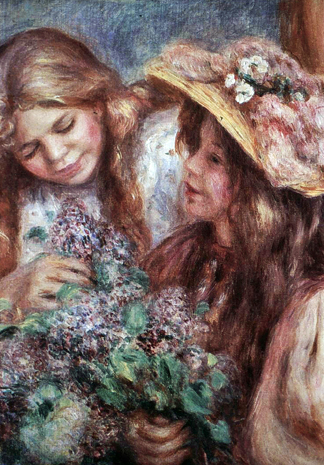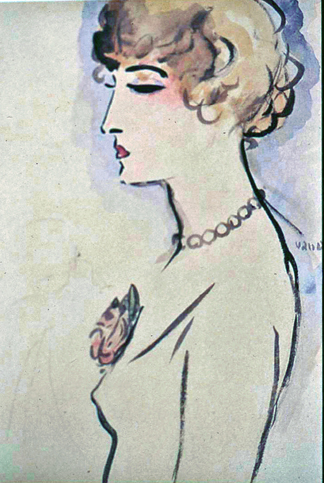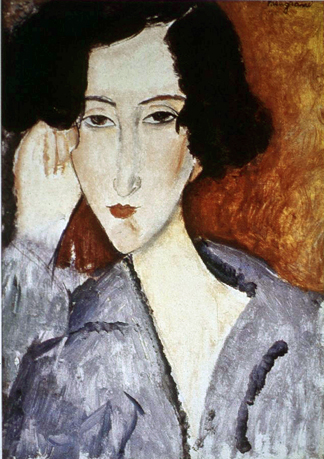“Stevenson and Spampinato” at the Sea Cliff Museum;
“The Subject is Women” at the Nassau County Museum of Art
By Ginger Lee Hendler
ART TIMES Mar/ Apr 2010
 Pierre August Renoir Jeunes Filles aux Lilas, c. 1890, oil on canvas, The Lois and David Lerner Collection |
Nestled behind the Village Hall in Sea Cliff, New York, is a tiny historical museum that houses artifacts which continue to bring to life past generations of Sea Cliffers who have made their homes in this mile square Victorian village. Sara Reres, the director/curator of the Sea Cliff Village Museum has undertaken a challenge in finding a home for the current exhibit. For several months, she has transformed the space into an art museum, exhibiting paintings and sculptures by the founders and students of the Long Island based Stevenson Academy of Traditional Painting. It features original work from renowned Norman Rockwell student, Harold Ransom Stevenson, his wife Alma Gallanos Stevenson, sculptor Clemente Spampinato, and several of their students.
Harold Stevenson’s work is beautifully executed, most evident in “Sea Harvest”, an oil on canvas depicting five shells and their luminous reflections. The impeccable placement of each shell with the correlate shells carefully displayed in a case below the painting is an exercise in overlapping and composition. The real shells rest on a mirrored glass shelf, so if one bends down it is possible to see the same reflection Stevenson painted. Adjacent to the shells, in the same case, are brushes that were used by Stevenson. Alma’s work is softer, more impressionistic. There is a more painterly style to her brushwork. On one wall there are two paintings side-by-side, one by Stevenson and the other by his wife. Stevenson’s, entitled “Lumiere du Matin”, depicts a woman wrapped in gold cloth with flowers in the background. The full-figured nude in Alma’s painting is a young woman surrounded by flowers. There is a golden cast in both paintings; however the lighting in the room is somewhat harsh, producing a strong glare. Many of the paintings, part of private collections, have no labels with titles or details about the medium. How the brain processes the work with minimal information is an interesting question because in many cases we are given too much text and the viewer often spends too much time reading rather than studying the work itself. “Lefthanded Nude” by Alma Gallanos Stevenson is my favorite piece in the exhibit. It was done when the artist suffered from a pinched nerve which rendered her right arm paralyzed. There is a lovely loose quality to this pen and wash. Clemente Spampinato was schooled in Rome as a classical artist. He had a passion for the art of sports and the American Old West. His sculptures are filled with energy and exude the moment of heightened movement, with tendons and muscles alive with tension. The Spampinato sculptures in this collection all resonate with dynamism.
 Kees Van Dongen Femme à la Rose, 1922, watercolor on paper, Collection of Arthur and Arlene Levine Kees Van Dongen Femme à la Rose, 1922, watercolor on paper, Collection of Arthur and Arlene Levine |
The second gallery consists of the work of several painters who studied with the Stevensons, including the work of Attila Hejja, a Hungarian born artist who apprenticed with Harold Ransom Stevenson and became a protégé of Norman Rockwell.
I was moved by the letters Norman Rockwell wrote to Stevenson asking him to do some of the background military planes for a Saturday Evening Post issue. It said more about the importance of connections and history than it did about the individual pieces. This show is worth seeing, not only for the artwork, but for the valuable glimpse into local history. Sea Cliff is a charming area to include as a destination, and is the home and inspiration for many fine artists.
*Stevenson and Spampinato,”(Through May 1), Saturdays and Sundays, 2 to 5 p.m. Sea Cliff Museum, 95 10th Avenue. (516) 671-0090; seacliff-ny.gov.
“The Subject is Women” filled three galleries on the main floor at the Nassau County Museum of Art set within the sumptuous grounds of the Henry Clay Frick estate in Roslyn, NY.
According to the science of neuroesthetics, color is the first element captured by the eye and therefore the cerebral cortex. The deep Prussian blue walls in Gallery 1 offer an overcast and subdued backdrop for the paintings it holds. The frames were characteristically ornate, yet somewhat distracting. The work was hung with precision, albeit a bit monotonous. There were five small works by Camille Pissarro in this gallery. These pieces seemed to belie the adjacent text, which spoke of the way Impressionism burst onto the art scene with an explosion of color and light. Impressionism, being all about light, was not necessarily evident in these choices. Nevertheless, the dark, somewhat shadowy presence of the peasant women, chosen as the subjects, are gems rendered in charcoal, pastel, and watercolor on paper. “Paysanne assise epluchant un chou” is a charming pastel depicting a seated woman holding a green cabbage in the folds of her blue skirt. The color is soft and suffused with light; the lines delicately outlining the figure. Her head is turned down, and her strong hands hold the freshly picked vegetable. In the absence of too much detail, the eye is able to fill in the rest. If we compare it to the more fully developed “Le marche de Gisors rue Cappeville”, depicting the crowded marketplace with the peasant woman in the foreground, we are given ample information. Our eye might linger awhile and then travel throughout, allowing our mind to take it all in. A Renoir pastel and charcoal, ”La Baigneuse”, beautifully reveals the shoulders of the figure, blending into the shadowy charcoal. Two small nudes by Aristide Maillol “Jeune fille debout de dos”, one a lithograph and the other done in sanguine on paper, were particularly appealing.
 Amedeo Modigliani Portrait of Madame Rachele Osterlind, 1919, oil on canvas, Private Collection |
Gallery 2 held my attention with its deep red burgundy walls embracing the warm hues of the paintings. Were they specifically mounted because they matched the walls? The Modigliani on the sidewall seemed lonely, set apart on a large wall that seemed almost too big. I am sure that the curator’s intention was to give it a place of honor it so clearly deserved along with the other starsin this collection. Glancing back at “Portrait of Rachele Osterlind”, oil on canvas, the rich contrast of the red ground and the deep black of her hair vibrated. The signature eyes and the elongated face are like old friends. How does the brain respond to that? Vuillard’s “L’Actrice (Marthe Merlor singing at the Moulin Rouge)”, oil on board, is a tiny treat. With the paint thickly applied and the few gestural strokes, it was dramatic with a touch of the naïve. Again I found myself responding to the hint of red and the movement of the dancerly feet and outstretched arms. Two other works by Vuillard, interior settings, each with two female figures, are filled with beautiful patterns and fine compositions. “Portrait of a Lady in a Red Blouse with Hat and Flowers” by Alexei Jawlensky, a Russian born artist, shows a woman whose deep dark eyes stare blankly. Although the features are delineated, the portrait wears a sense of mystery. Kees Van Dongen’s “Femme a la rose”, watercolor on paper looks as if it could have been an early cover of Vogue Magazine. There were over 57 works gathered in this exhibit from nine different sources, a worthwhile exhibit with some of the world’s most renowned artists.
* “The Subject is Women,” (January 10 through February 28, 2010). Nassau County Museum of Art, One Museum Drive, Roslyn Harbor, NY 11576 (516)484-9337 nassaumuseum.org
A Look Ahead:
“Something’s a Foot: Small Works from the Hofstra University Museum Collection ,” an exhibition of varied media, all measuring 12 inches or less. (Through September 12), Tuesdays through Fridays, 10 a.m. to 5p.m.; Saturdays and Sundays, 1 to 5 p.m. Hofstra Museum, 112 Hofstra University. (516) 463-5672; hofstra.edu/museum.org
"Art is Deformation" Fernando Botero: A major exhibition that showcases work by one of the most honored Latin American artists working today, Fernando Botero includes a range of paintings, drawings and monumental sculpture that exemplify Botero's most familiar themes: commonplace scenes of everyday life, life in the bedroom, life of the streets and people rapt in the excitement of music or family activities. “Dubuffet/Miro/Basquiat”: (March 13, 2010 through May 24, 2010 ), Nassau County Museum of Art, One Museum Drive, Roslyn Harbor, NY, 11576 (516)484-9337 nassaumuseum.org ( March 13, 2010 through May 24, 2010)
